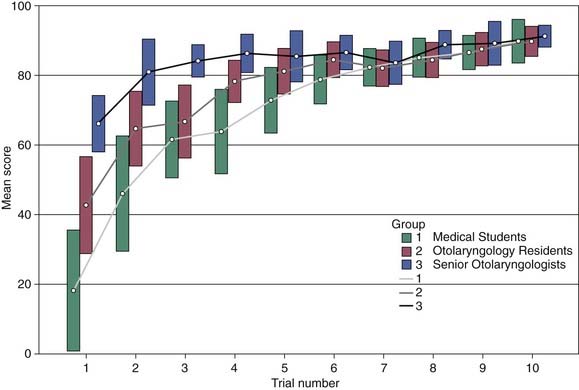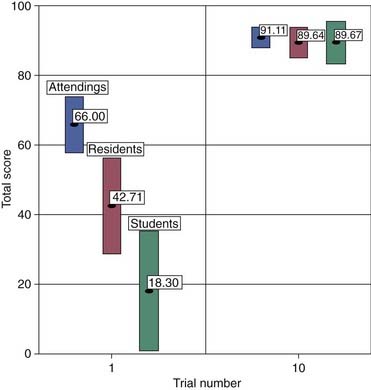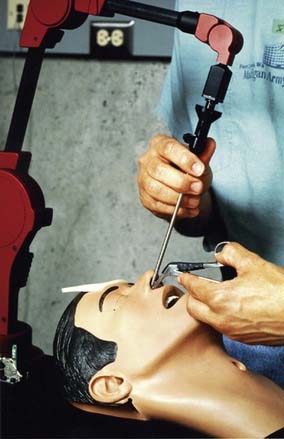CHAPTER 4 B Simulation and Haptics in Otolaryngology Training
Surgical skills training must be predicated on standard and well-tested methods of instruction. Besides hands-on operative experience on live patients, resident training currently relies on video tapes and cadaver dissection where available. Some institutions have used cadavers to provide the first surgical experience to residents learning endoscopic sinus surgery. Stankiewicz has long been a proponent of a rigorous curriculum using cadaveric dissection before performing a first sinus surgery procedure, although the utility of such a method has never been demonstrated.1 More frequently, direct observation of procedures in the operating room is employed, with increased responsibility as residents progress in training, ultimately becoming the major participant by their final year.
In light of the increasing scrutiny on the medical profession, diminishing patient risk is of paramount concern, particularly for surgical procedures. Medical simulator technology provides interim training media wherein proficiency can be achieved before entering the operating room. Indeed, the science of simulation, well past 50 years of implementation in other high-risk professions (e.g., aviation industry, nuclear power plants), has already demonstrated the following capabilities (Brandon Hall Research News, 2005, available at www.brandon-hall.com):
High-fidelity virtual reality (VR) simulators have long had an impact on improving the skill level of military and commercial pilots, and they hold similar promise for the medical field. With a validated surgical simulator, proficiency criteria can be attained before permitting the student surgeon to operate upon a patient. Based on the lessons from aviation training over the past 3 decades, computer-assisted devices have had significant success in augmenting the education and training of surgical residents in a number of fields.2–5 VR simulation has already played a role in the training of residents for laparoscopic, gastrointestinal, plastic, ophthalmologic, dermatologic, urologic, and some laryngologic procedures.6–13 The efficacy of VR simulation as a teaching tool is evident, and its superiority to conventional teaching methods is increasingly accepted. Recently, it has been reported that virtual reality training impacts positively not only on resident operating room performance but also potentially on safety.14
During the past 15 years, medical simulation technology has gained substantial support. Validation studies have established that surgical skills trained using medical simulation significantly improved trainee performance by decreasing operating times, improving efficiency, and decreasing errors. The medical profession, academics, authoritative organizations (training, testing, licensing and certification bodies) and corporate partners have accepted the importance of simulation within the context of a quantitative assessment environment unique to simulators. The impact on patient safety is a priori—that is, make the corrections on a simulator, not on a patient. For instance, the American College of Surgeons is interested in promoting surgical simulators by identifying targets for simulation; researching, writing, and implementing the plan for medical simulation training; and investigating sources of funding.15 Simulation is expected to soon provide a full range of possible surgical conditions wherein training can occur without placing a patient at risk. Otolaryngology has been a leading field in virtual reality simulation, mainly with efforts in the specific spheres of paranasal sinus surgery and temporal bone surgery simulation.
Endoscopic Sinus Surgery
The impact of sinus disease on quality of life as well as social and work performance is significant.16,17 In 2004, 31 million Americans, almost 14% of the population, suffered from sinus disease.18 Every year, sinus disease sufferers account for 12.5 million visits to office-based physicians and 1.1 million hospital outpatient visits per year.19 The overall direct expenditures attributable to sinusitis in 1996 were estimated at $5.8 billion, of which $1.8 billion (31%) was incurred to treat children 12 years of age or younger.20 Because of the limitations of large-scale evaluations, these figures likely underestimate true direct costs.21 The indirect costs of sinusitis are staggering too: the number of total restricted activity days due to sinusitis rose from approximately 50 million per year between 1986 and 1988 to 73 million per year between 1990 and 1992.18
In 2004, Lynn-Macrae and colleagues queried a computerized legal database to retrospectively analyze state and federal civil litigation involving injuries resulting from endoscopic sinus surgery (ESS) between 1990 and 2003. They observed that 76% of ESS-related malpractice suits were prompted by alleged negligent technique, with an average verdict award of $751,275.22
Surgery is used when medications fail or when complications of the sinus disease ensue. ESS was first introduced in the 1970s and has since been established as the standard of care for operative treatment of the sinuses and nasal cavity.23–26 ESS involves the introduction of delicate surgical instruments through the nares to perform exacting maneuvers for a wide range of surgical interventions involving the paranasal sinuses and the cranial base. Although the concept of ESS is straightforward, skillfully performing the procedure can be challenging.27 The relevant anatomy is highly complex and compact, with the added concern of the vicinity of such important structures as the brain, orbital contents, and carotid artery.1,28 With very little room for error, the surgeon must navigate and manipulate instrumentation using dominant and nondominant hands simultaneously, while coordinating movements indirectly with the aid of a television monitor. Precise hand-eye coordination is an obvious prerequisite. The ESS technique provides the surgeon with excellent visualization, supplemented by an array of instruments that permit access to the depths of the sinuses and to the cranial base. The use of a computer-based image-guidance system (IGS) adds to these capabilities by providing unprecedented navigational support to reach the area of interest while delineating the surrounding anatomy that is not at pathologic risk. The applications of endoscopic procedures have expanded widely as safety and efficacy have been documented.29–31
Endoscopic Sinus Surgery Simulator
The technical acumen required for basic ESS procedures is not achieved, for the most part, until the later half of a resident’s training. With the increase in the complexity of microdissection equipment and the growing demand to broaden the indications of ESS,32 there is a real need to make residents more familiar with the technical skills of ESS at an earlier stage in training. As technology matures, the need for simulators to teach surgery has become apparent.33 Again otolaryngology took a leadership role in this venture with the conception in 1996 by Department of Defense contractor Lockheed Martin Corporation of the Endoscopic Sinus Surgery Simulator (ES3) (Fig. 4B-1). The system employs virtual anatomy and instruments, visual and haptic (force) feedback, voice commands, phased instruction, and performance monitoring to create a virtual reality environment designed to train otolaryngology residents.13,34–37 The simulator provides spatial relationships, ability to maneuver in operating space, presentation of sinus anatomy, common surgical instruments, and basic to advanced surgical technologies. The ES3 development team conducted evaluation studies13,34–37 that have been followed by a series of formal scientific validation studies by multi-institutional academic and corporate consortia.
The development team also developed a prototype intelligent multimodal expert surgical assistant for the ES3.38 The system, which incorporates knowledge of the endoscopic procedure into a structured rule base, interprets the user’s multimodal inputs (currently voice and virtual endoscope position) and interacts with the user dynamically. While performing the simulated procedure, the user can query the system about anatomy and the specifics of the procedure, asking the system to identify features or demonstrate maneuvers. In turn the system recognizes the user’s actions and can provide vocal and visual feedback, as well as warnings when the user is about to execute a dangerous maneuver. In addition to enhancing simulation for training purposes, the expert surgical assistant can also be used for guidance during actual surgical procedures. This assistance can be particularly helpful for procedures in which situation awareness is diminished due to the complexity of the anatomy or to surgical complications.
One of the initial first validation studies of the ES3 specifically addressed the system’s discriminant and concurrent validity, by comparing cumulative performance levels between medical students, otolaryngology residents, and otolaryngology attendings as groups, thereby establishing attending benchmark data against which residents and medical students can be measured. The simulator performance data of 10 medical students were compared with those of 14 otolaryngology residents and 10 attending otolaryngologists. The results (Figs. 4B-2 and 4B-3) clearly demonstrated significant differences in performance among the three groups. Attending otolaryngologists perform the best at all levels, with residents close behind and medical students performing substantially subpar to residents. However, by the end of the curriculum (i.e., trial 10), all groups achieved plateau scores included within a remarkably narrow range. This illustrates the consistency and relatively low variability of performance after simulator training, allowing the instructors to set predefined performance goals tailored to the educational needs of the trainees.39 A spinoff observation yielded by the study of medical student performance showed that, after a critical period of training had been accomplished, the performance of the trainee did not substantially diminish even after 1 month without simulator training.40 Hence, the transfer of complex skills facilitated by the ES3 produces long-lasting and memorable performance. This has implications with regard to the use of surgical simulation as a meaningful training tool in an effort to reduce surgical errors and increase patient safety.

Figure 4B-2. Performance over 10 trials on the ES3 novice level by otolaryngology attendings, residents, and medical students.
(From Fried MP, Sadoughi B, Weghorst SJ, et al. Construct validity of the endoscopic sinus surgery simulator: II. Assessment of discriminant validity and expert benchmarking. Arch Otolaryngol Head Neck Surg. 2007;133[4]:350-357.)

Figure 4B-3. Performance range variability between trials 1 and 10.
(From Fried MP, Sadoughi B, Weghorst SJ, et al. Construct validity of the endoscopic sinus surgery simulator: II. Assessment of discriminant validity and expert benchmarking. Arch Otolaryngol Head Neck Surg. 2007;133[4]:350-357.)
A second validation study was designed to correlate the performance of subjects on the ES3 with their performance on other validated tests of innate ability. Indeed, ESS requires two-handed coordination of surgical instruments with an endoscope in three-dimensional space. The technique necessitates complex ambidextrous psychomotor, visuospatial, and perceptual capabilities. This second set of studies aimed to assess whether objective tests of such fundamental abilities might also predict performance on the ES3. Results assessed on 34 medical students and four otolaryngology residents showed conclusively that statistically significant correlations exist between performance on various validated tests and the ES3 (Table 4B-1).39 This confirmed the robustness and utility of the ES3 and helped develop a multifaceted and enriched learning environment designed to reduce surgical errors and improve patient safety in the operating room.
Stay updated, free articles. Join our Telegram channel

Full access? Get Clinical Tree




